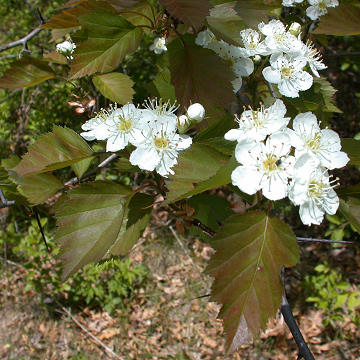

Crataegus pruinosa - (image 1 of 3)
Taxonomy
Family: Rosaceae
Habitat
Disturbed woodland; old alluvial soils.
Associates
Distribution
Newfoundland south to NC, west to WI and OK.
Morphology
Upright shrub or small tree to 8 m; branches intricately thorny. Leaves firm, rounded or truncate to subcordate at the base, broadly ovate, deltoid, rhombic or elliptic, scarcely lobed, to 6 cm long and 5 cm wide, usually glabrous even when young; petiole a third to as long as the blade. Flowers to 2 cm wide in simple, glabrous cymes; sepals narrow, simple or only weakly glandular-serrate; stamens usually 15 or more. Fruit usually red but sometimes greenish, to 1.5 cm thick, the calyx prominent and elevated on a distinct rim or pad; nutlets usually 3-5.
Notes
Flowers in May
Wetland indicator: Upland
Flowers around the same time as Malus coronaria, which was blooming nearby where these pictures were taken in southeast WI. The fruit is sometimes glaucous (waxy), hence the common name; the specific epithet also means "frosted".
References
Gleason, Henry A.
and A. Cronquist. 1991. Manual of Vascular Plants of Northeastern United States
and Adjacent Canada. Second Ed.
The New York Botanical Garden. Bronx, NY
Swink, F. and G. Wilhelm. 1994. Plants of the Chicago Region.
Indiana Academy of Science. The Morton Arboretum. Lisle, Illinois.
|
Michael Hough © 2010 |